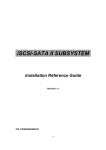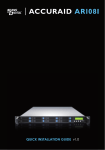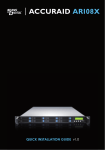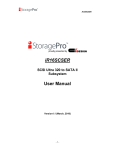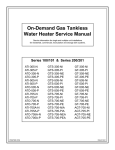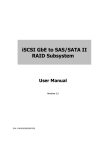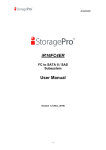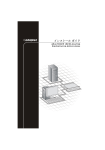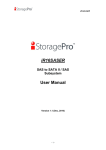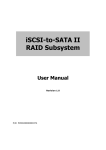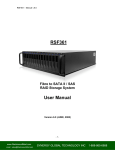Download SB-3164E-G1A3
Transcript
iSCSI-SATA II SUBSYSTEM Installation Reference Guide Revision 1.1 P/N: PW0020000000282 -1- Preface About this manual This manual is the introduction of iSCSI-SATA II RAID subsystem, and to help user to know the operation of the disk array system easily. Information contained in the manual has been reviewed for accuracy, but not for product warranty because of the various environments/OS/settings, Information and specification will be changed without further notice. Copyright No part of this publication may be reproduced, stored in a retrieval system, or transmitted in any form or by any means, electronic, mechanical, photocopying, recording or otherwise, without the prior written consent. Trademarks All products and trade names used in this document are trademarks or registered trademarks of their respective holders. Changes The material in this document is for information only and is subject to change without notice. -2- Table of Contents Chapter 1 1.1 1.2 1.3 RAID introduction.......................................... 5 Features........................................................................... 5 Terminology ..................................................................... 6 RAID levels ...................................................................... 8 Chapter 2 2.1 2.2 2.3 Getting started ............................................. 10 Before starting................................................................ 10 Unpacking the Subsystem ............................................. 10 Identifying Parts of the subsystem ................................. 11 2.3.1 2.3.2 2.4 2.5 2.6 2.7 2.8 Front View...............................................................................................11 Rear View ...............................................................................................13 Connecting iSCSI subsystem to Your Network.............. 15 Powering-on the Subsystem .......................................... 15 Install Hard Drives.......................................................... 16 iSCSI introduction .......................................................... 17 Management methods ................................................... 18 2.8.1 2.8.2 2.8.3 2.9 Web GUI .................................................................................................18 Console serial port..................................................................................19 Remote control – secure shell................................................................19 Enclosure ....................................................................... 20 2.9.1 2.9.2 LCM ........................................................................................................20 System buzzer........................................................................................22 Chapter 3 3.1 3.2 3.3 3.4 Web GUI guideline....................................... 23 SB-3164E-G1A3 GUI hierarchy ..................................... 23 Login .............................................................................. 24 Quick install.................................................................... 25 System configuration ..................................................... 27 3.4.1 3.4.2 3.4.3 3.4.4 3.4.5 3.4.6 3.4.7 3.4.8 3.4.9 3.4.10 3.4.11 3.5 System name..........................................................................................28 IP address...............................................................................................28 Language................................................................................................28 Login config ............................................................................................29 Password ................................................................................................29 Date ........................................................................................................30 Mail .........................................................................................................30 SNMP .....................................................................................................31 Messenger ..............................................................................................32 System log server...................................................................................32 Event log.................................................................................................33 iSCSI config ................................................................... 34 3.5.1 3.5.2 3.5.3 Entity property ........................................................................................34 NIC..........................................................................................................35 Node .......................................................................................................37 -3- 3.5.4 3.5.5 3.6 Session ...................................................................................................37 CHAP account ........................................................................................38 Volume configuration ..................................................... 38 3.6.1 3.6.2 3.6.3 3.6.4 3.6.5 3.6.6 3.6.7 3.7 Volume relationship diagram..................................................................39 Physical disk ...........................................................................................40 Volume group .........................................................................................42 User data volume ...................................................................................44 Cache volume.........................................................................................46 Logical unit number ................................................................................47 Examples ................................................................................................48 Enclosure management ................................................. 59 3.7.1 3.7.2 3.7.3 3.7.4 3.8 SES configuration...................................................................................60 Hardware monitor ...................................................................................60 Hard drive S.M.A.R.T. function support .................................................62 UPS ........................................................................................................63 System maintenance ..................................................... 64 3.8.1 3.8.2 3.8.3 3.8.4 3.8.5 3.9 Upgrade ..................................................................................................64 Info ..........................................................................................................65 Reset to default ......................................................................................65 Config import & export............................................................................66 Shutdown................................................................................................68 Logout ............................................................................ 68 Chapter 4 4.1 4.2 4.3 4.4 Rebuild........................................................................... 69 VG migration and expansion.......................................... 71 UDV Extension............................................................... 73 Snapshot /Rollback ........................................................ 74 4.4.1 4.4.2 4.4.3 4.5 4.6 Advanced operation .................................... 69 Create snapshot volume ........................................................................75 Auto snapshot.........................................................................................76 Rollback ..................................................................................................77 Disk roaming .................................................................. 78 Support Microsoft MPIO and MC/S................................ 78 Appendix............................................................................ 80 A. B. C. D. E. F. G. H. Certification list............................................................... 80 Event notifications .......................................................... 82 Known issues................................................................. 86 Microsoft iSCSI Initiator.................................................. 86 Trunking/LACP setup instructions.................................. 91 MPIO and MC/S setup instructions .............................. 101 QLogic QLA4010C setup instructions .......................... 117 Installation Steps for Large Volume (TB) ..................... 122 -4- Chapter 1 RAID introduction 1.1 Features 2 x GbE ports support independent access, fail-over or load-balancing (802.3ad port trunking, LACP) Supports iSCSI jumbo frame Supports Microsoft Multipath I/O (MPIO) Supports RAID levels 0,1,0+1,3,5,6,10,30,50, 60 and JBOD Local N-way mirror: Extension to RAID 1 level, N copies of the disk. Global and dedicated hot spare disks Write-through or write-back cache policy for different application usage Dedicated or shared cache allocation for volume usage Supports greater than 2TB per volume set (64-bit LBA support) Supports manual or scheduling volume snapshot (up to 32 snapshot) Snapshot rollback mechanism Online volume migration with no system down-time Online volume expansion Instant RAID volume availability and background initialization Supports S.M.A.R.T, NCQ and OOB Staggered Spin-up capable drives SB-3164E-G1A3 connects to the host system in iSCSI interface. It can be configured to any RAID level. SB-3164E-G1A3 provides reliable data protection for servers and the RAID 6 function ready. The RAID 6 function allows two HDD failures without any impact on the existing data. Data can be recovered from the remaining data and parity drives. (Data can be recovered from the rest disks/drives.) Snapshot-on-the-box is a fully usable copy of a defined collection of data that contains an image of the data as it appeared at the point in time, which means a point-in-time data replication. It provides consistent and instant copies of data volumes without any system downtime. SB-3164E-G1A3 Snapshot-on-the-box can keep up to 32 snapshots for all data volumes. Rollback feature is provided for restoring the previously-snapshot data easily while continuously using the volume for further data access. The data access is regular as usual including read/write without any impact to end users. The "on-the-box" terminology implies that it does not require any proprietary agents installed at host side. The snapshot is taken at target side and done by SB-3164E-G1A3. It will not consume any host CPU time thus the server is dedicated to the specific or other application. The snapshot copies can be taken manually or by schedule every hour or every day, depends on the modification. -5- SB-3164E-G1A3 is the most cost-effective disk array subsystem with completely integrated high-performance and data-protection capabilities which meet or exceed the highest industry standards, and the best data solution for small/medium business users. Caution Snapshot/rollback features need 512MB RAM or more. Please refer to RAM certification list in Appendix A for more detail. 1.2 Terminology The document uses the following terms: RAID RAID is the abbreviation of “Redundant Array of Independent Disks”. There are different RAID levels with different degree of the data protection, data availability, performance to host environment. PD The Physical Disk belongs to the member disk of one specific volume group. VG Volume Group. A collection of removable media. One VG consists of a set of UDVs and owns one RAID level attribute. UDV User Data Volume. Each VG could be divided into several UDVs. The UDVs from one VG share the same RAID level, but may have different volume capacity. CV Cache Volume. SB-3164E-G1A3 uses the on board memory as cache. All RAM (except for the part which is occupied by the controller) can be used as cache. User can divide the cache for one UDV or sharing among all UDVs. Each UDV will be associated with one CV for data transaction. Each CV could be assigned different cache memory size. LUN Logical Unit Number. A logical unit number (LUN) is an unique identifier used on a iSCSI connection which enables it to differentiate among separate devices (each of which is a logical unit). -6- GUI Graphic User Interface. RAID width, RAID copy, RAID row (RAID cell in one row) RAID width, copy and row are used to describe one VG. E.g.: 1. One 4-disk RAID 0 volume: RAID width= 4; RAID copy=1; RAID row=1. 2. One 3-way mirroring volume: RAID width=1; RAID copy=3; RAID row=1. 3. One RAID 10 volume over 3 4-disk RAID 1 volume: RAID width=1; RAID copy=4; RAID row=3. WT Write-Through cache write policy. A caching technique in which the completion of a write request is not signaled until data is safely stored on non-volatile media. Each data is synchronized in both data cache and the accessed physical disks. WB Write-Back cache write policy. A caching technique in which the completion of a write request is signaled as soon as the data is in cache and actual writing to non-volatile media occurs at a later time. It speeds up system write performance but needs to bear the risk where data may be inconsistent between data cache and the physical disks in one short time interval. RO Set the volume to be Read-Only. DS Dedicated Spare disks. The spare disks are only used by one specific VG. Others could not use these dedicated spare disks for any rebuilding purpose. GS Global Spare disks. GS is shared for rebuilding purpose. If some VGs need to use the global spare disks for rebuilding, they could get the spare disks out from the common spare disks pool for such requirement. DC Dedicated Cache. GC Global Cache. DG DeGraded mode. Not all of the array’s member disks are functioning, but the array is able to respond to application read and write requests to its virtual disks. -7- S.M.A.R.T. Self-Monitoring Analysis and Reporting Technology. WWN World Wide Name. HBA Host Bus Adapter. MPIO Multi-Path Input/Output. MC/S Multiple Connections per Session S.E.S SCSI Enclosure Services. NIC Network Interface Card. iSCSI Internet Small Computer Systems Interface. LACP Link Aggregation Control Protocol. MTU Maximum Transmission Unit. CHAP Challenge Handshake Authentication Protocol. An optional security mechanism to control access to an iSCSI storage system over the iSCSI data ports. iSNS Internet Storage Name Service. 1.3 RAID levels RAID 0 Disk striping. RAID 0 needs at least one hard drive. RAID 1 Disk mirroring over two disks. RAID 1 needs at least two hard drives. N-way mirror Extension to RAID 1 level. It has N copies of the disk. RAID 3 Striping with parity on the dedicated disk. RAID 3 needs at least three hard drives. RAID 5 Striping with interspersed parity over the member disks. RAID 3 needs at least three hard drives. -8- RAID 6 2-dimensional parity protection over the member disks. RAID 6 needs at least four hard drives. RAID 0+1 Mirroring of the member RAID 0 volumes. RAID 0+1 needs at least four hard drives. RAID 10 Striping over the member RAID 1 volumes. RAID 10 needs at least four hard drives. RAID 30 Striping over the member RAID 3 volumes. RAID 30 needs at least six hard drives. RAID 50 Striping over the member RAID 5 volumes. RAID 50 needs at least six hard drives. RAID 60 Striping over the member RAID 6 volumes. RAID 60 needs at least eight hard drives. JBOD The abbreviation of “Just a Bunch Of Disks”. JBOD needs at least one hard drive. -9- Chapter 2 Getting started 2.1 Before starting Before starting, prepare the following items. Check the “Certification list” in Appendix A to confirm the hardware setting is fully supported. Read the latest release notes before upgrading. Release notes accompany with release firmware. A server with a NIC or iSCSI HBA. CAT 5e, or CAT 6 network cables for management port and iSCSI data ports. Recommend CAT 6 cables for best performance. Prepare storage system configuration plan. Management and iSCSI data ports network information. When using static IP, please prepare static IP addresses, subnet mask, and default gateway. Gigabit LAN switches. (Recommended) or Gigabit LAN switches with VLAN/LACP/Trunking functions. (Optional) CHAP security information, including CHAP usernames and secrets. (Optional) Setup the hardware connection before power up servers and SB3164E-G1A3. Connect console cable, management port cable, and iSCSI data port cables first. 2.2 Unpacking the Subsystem Before we continue, you need to unpack the subsystem and verify that the contents of the shipping carton are all there and in good condition. Before removing the subsystem from the shipping carton, you should visually inspect the physical condition of the shipping carton. Exterior damage to the shipping carton may indicate that the contents of the carton are damaged. If any damage is found, do not remove the components; contact the dealer where you purchased the subsystem for further instructions. The package contains the following items: • iSCSI RAID subsystem unit • Two power cords • Three Ethernet LAN cables • One external null modem cable • Installation Reference Guide • Spare screws, etc. If any of these items are missing or damaged, please contact your dealer or sales representative for assistance. - 10 - 2.3 Identifying Parts of the subsystem The illustrations below identify the various features of the subsystem. Get yourself familiar with these terms as it will help you when you read further in the following sections. 2.3.1 Front View Reserve for other model 1. HDD status Indicator Parts HDD Status LEDs HDD access LEDs Function Green LED indicates power is on and hard drive status is good for this slot. If hard drive defected in this slot or the hard drive is failure, the LED is orange. These LED will blink blue when the hard drive is being accessed. - 11 - 2. HDD trays 1 ~ 16 (From right to left) 3. Smart Function Panel - Function Keys Parts Function Access LED Blue blinking LED indicates data is being accessed. 4. LCD display panel 5. Smart Function Panel - Function Keys for RAID configuration The smart LCD panel is where you will configure the RAID subsystem. If you are configuring the subsystem using the LCD panel, please press the controller button to configure your RAID subsystem. Parts Function Up and Down arrow buttons Use the Up or Down arrow keys to go through the information on the LCD screen. This is also used to move between each menu when you configure the subsystem. Select button This is used to enter the option you have selected. Exit button Press this button to return to the previous menu. 6. Environment status Parts Function Voltage warning An alarm will sound warning of a voltage abnormality and this LED will turn red. LED Over temp LED If temperature irregularity in these systems occurs (HDD slot temperature over 45oC), this LED will turn red and an alarm will sound. Fan fail LED When a fan fails, this LED will turn red and an alarm will sound. Power fail LED If a redundant power supply fails, this LED will turn red and an alarm will sound. Power LED Green LED indicates power is on. 7. Tray Lever 8. Tray Latch - 12 - 2.3.2 Rear View 1. Uninterrupted Power Supply (UPS) Port (APC Smart UPS only) The subsystem may come with an optional UPS port allowing you to connect a APC Smart UPS device. Connect the cable from the UPS device to the UPS port located at the rear of the subsystem. This will automatically allow the subsystem to use the functions and features of the UPS. 2. R-Link Port: Remote Link through RJ-45 ethernet for remote management The subsystem is equipped with one 10/100 Ethernet RJ45 LAN port. You use web-based browser to management RAID subsystem through Ethernet for remote configuration and monitoring. 3. Monitor Port The subsystem is equipped with a serial monitor port allowing you to connect a PC or terminal. 4. Fan Fail indicator If a fan fails, this LED will turn red. 5. Cooling Fan module Two blower fans are located at the rear of the subsystem. They provide sufficient airflow and heat dispersion inside the chassis. In case a fan fails to function, the ” Fan fail LED will turn red and an alarm will sound. “ - 13 - 6. Power Supply Power On Indicator Green LED indicates power is on. 7. System Power On Indicator Green LED indicates power is on. 8. Power Supply Unit 1 ~ 2 Two power supplies (power supply 1 and power supply 2) are located at the rear of the subsystem. Turn on the power of these power supplies to power-on the subsystem. The “power” LED at the front panel will turn green. If a power supply fails to function or a power supply was not turned on, the “ Power fail LED will turn red and an alarm will sound. - 14 - ” 2.4 Connecting iSCSI subsystem to Your Network To connect the iSCSI unit to the network, insert the cable that came with the unit into the network connection (LAN1) on the back of iSCSI unit. Insert the other end into a Gigabit BASE-T Ethernet connection on your network hub or switch. 2.5 Powering-on the Subsystem You should press the ON/OFF Power Supply Switch on the Switch. It will turn the iSCSI unit on and the Self-Test will be started automatically. 1. Plug in all the power cords or power connectors located at the rear of the subsystem. 2. You should press the ON/OFF Power supply switch to turn on the power. 3. The “Power” LED on the front panel will turn green. - 15 - 2.6 Install Hard Drives This section describes the physical locations of the hard drives supported by the subsystem and gives instructions on installing a hard drive. The subsystem supports hot-swapping allowing you to install or replace a hard drive while the subsystem is running. 1. Pull out an empty disk tray. (You can install in any available slot.) 2. Take off the bracket before installing hard drive. 3. Place the hard drive in the disk tray. 4. Install the mounting screws on each side to secure the drive in the mobile rack. Note: Insert screws through the front sides of the mounting holes. 5. Slide the tray into a slot until it clicks into place. The HDD status LED will turn green on front panel. 6. Press the lever in until you hear the latch click into place. 7. If the HDD power LED did not turn green, check the hard drive is in good condition. If the hard drive is not being accessed, the HDD access LED will not illuminate. The LED blinks only when being accessed. - 16 - 2.7 iSCSI introduction iSCSI (Internet SCSI) is a protocol which encapsulates SCSI (Small Computer System Interface) commands and data in TCP/IP packets for linking storage devices with servers over common IP infrastructures. iSCSI provides high performance SANs over standard IP networks like LAN, WAN or the Internet. IP SANs are true SANs (Storage Area Networks) which allow few of servers to attach to an infinite number of storage volumes by using iSCSI over TCP/IP networks. IP SANs can scale the storage capacity with any type and brand of storage system. In addition, using any type of network (Ethernet, Fast Ethernet, Gigabit Ethernet) and combining operating systems (Microsoft Windows, Linux, Solaris, …etc.) within the SAN network. IP-SANs also include mechanisms for security, data replication, multi-path and high availability. Storage protocol, such as iSCSI, has “two ends” in the connection. These ends are the initiator and the target. In iSCSI we call them iSCSI initiator and iSCSI target. The iSCSI initiator requests or initiates any iSCSI communication. It requests all SCSI operations like read or write. An initiator is usually located on the host/server side (either an iSCSI HBA or iSCSI SW initiator). The iSCSI target is the storage device itself or an appliance which controls and serves volumes or virtual volumes. The target is the device which performs SCSI commands or bridges it to an attached storage device. iSCSI targets can be disks, tapes, RAID arrays, tape libraries, and etc. Host 2 (initiator) iSCSI HBA Host 1 (initiator) NIC IP SAN iSCSI device 1 (target) iSCSI device 2 (target) Figure 2.2.1 - 17 - The host side needs an iSCSI initiator. The initiator is a driver which handles the SCSI traffic over iSCSI. The initiator can be software or hardware (HBA). Please refer to the certification list of iSCSI HBA(s) in Appendix A. OS native initiators or other software initiators use the standard TCP/IP stack and Ethernet hardware, while iSCSI HBA(s) use their own iSCSI and TCP/IP stacks on board. Hardware iSCSI HBA(s) would provide its initiator tool. Please refer to the vendors’ HBA user manual. Microsoft, Linux and Mac provide software iSCSI initiator driver. Below are the available links: 1. Link to download the Microsoft iSCSI software initiator: http://www.microsoft.com/downloads/details.aspx?FamilyID=12cb3c1a-15d64585-b385-befd1319f825&DisplayLang=en Please refer to Appendix D for Microsoft iSCSI initiator installation procedure. 2. Linux iSCSI initiator is also available. For different kernels, there are different iSCSI drivers. If you need the latest Linux iSCSI initiator, please visit Open-iSCSI project for most update information. Linux-iSCSI (sfnet) and Open-iSCSI projects merged in April 11, 2005. Open-iSCSI website: http://www.open-iscsi.org/ Open-iSCSI README: http://www.open-iscsi.org/docs/README Features: http://www.open-iscsi.org/cgi-bin/wiki.pl/Roadmap Support Kernels: http://www.open-iscsi.org/cgi-bin/wiki.pl/Supported_Kernels Google groups: http://groups.google.com/group/open-iscsi/threads?gvc=2 http://groups.google.com/group/open-iscsi/topics Open-iSCSI Wiki: http://www.open-iscsi.org/cgi-bin/wiki.pl 3. ATTO iSCSI initiator is available for Mac. Website: http://www.attotech.com/xtend.html 2.8 Management methods There are three management methods to manage SB-3164E-G1A3, describe in the following: 2.8.1 Web GUI SB-3164E-G1A3 support graphic user interface to manage the system. Be sure to connect LAN cable. The default setting of management port IP is DHCP and the DHCP address displays on LCM; user can check LCM for the IP first, then open the browser and type the DHCP address: (The DHCP address is dynamic - 18 - and user may need to check every time after reboot again.) When DHCP service is not available, SB-3164E-G1A3 use zero config (Zeroconf) to get an IP address. E.g., on LCM. SB-3164E-G1A3 gets a DHCP address 192.168.10.50 from DHCP server. 192.168.10.50 SB-3164E-G1A3 ← http://192.168.10.50 or https://192.168.10.50 (https: connection with encrypted Secure Sockets Layer (SSL). Please be aware of the https function is slower than http.) Click any function at the first time; it will pop up a dialog to authenticate current user. Login name: admin Default password: 00000000 Or login with the read-only account which only allows seeing the configuration and cannot change setting. Login name: user Default password: 1234 2.8.2 Console serial port Use NULL modem cable to connect console port. The console setting is baud rate: 115200, 8 bits, 1 stop bit, and no parity. Terminal type: vt100 Login name: admin Default password: 00000000 2.8.3 Remote control – secure shell SSH (secure shell) is required for SB-3164E-G1A3 to remote login. The SSH client software is available at the following web site: SSHWinClient WWW: http://www.ssh.com/ Putty WWW: http://www.chiark.greenend.org.uk/ Host name: 192.168.10.50 (Please check your DHCP address for this field.) Login name: admin - 19 - Default password: 00000000 Tips SB-3164E-G1A3 Series only support SSH for remote control. For using SSH, the IP address and the password is required for login. 2.9 Enclosure 2.9.1 LCM There are four buttons to control SB-3164E-G1A3 LCM (LCD Control Module), including: (Escape), and (Enter). c (up), d (down), After booting up the system, the following screen shows management port IP and model name: 192.168.10.50 SB-3164E-G1A3 ← Press “ ”, the LCM functions “Alarm Mute”, “Reset/Shutdown”, “Quick Install”, “View IP Setting”, “Change IP Config” and “Reset to Default” will rotate by pressing c (up) and d (down). When there is WARNING or ERROR level of event happening, the LCM shows the event log to give users more detail from front panel too. The following table is function description. System Info View System information of Firmware Version & RAM Size. Alarm Mute Mute alarm when error occurs. Reset/Shutdown Reset or shutdown controller. Quick Install Quick three steps to create a volume. Please refer to section 3.3 for operation in web UI. View IP Setting Display current IP address, subnet mask, and gateway. - 20 - Change IP Config Set IP address, subnet mask, and gateway. There are 2 selections, DHCP (Get IP address from DHCP server) or set static IP. Reset to Default Reset to default sets password to default: 00000000, and set IP address to default as DHCP setting. Default IP address: 192.168.10.50 (DHCP) Default subnet mask: 255.255.255.0 Default gateway: 192.168.10.254 The following is LCM menu hierarchy. [System Info] [Alarm Mute] [Reset/Shutdown] [Quick Install] proIPS cd [View IP Setting] [Firmware Version] [RAM Size] [cYes Nod] [Reset] [Shutdown] RAID 0 (RAID 1/RAID 3/ RAID 5/RAID 6) xxxxxx GB [IP Config] [Static IP] [IP Address] [192.168.010.050] [IP Subnet Mask] [255.255.255.0] [IP Gateway] [192.168.010.254] [DHCP] [cYes Nod] [cYes Nod] Volume Size (xxxxxx G) Apply The Config [cYes [Static IP] [IP Subnet Mask] [IP Gateway] [Apply IP Setting] [Reset to Default] [cYes [cYes Nod] Nod] [IP Address] [Change IP Config] Adjust Volume Size Adjust IP address Adjust Submask IP Adjust Gateway IP [cYes Nod] Nod] Caution Before power off, it is better to execute “Shutdown” to flush the data from cache to physical disks. - 21 - 2.9.2 System buzzer The system buzzer features are describing in the following: 1. 2. 3. The system buzzer alarms 1 second when system boots up successfully. The system buzzer alarms continuously when there is error level event happened. The alarm will be stopped after mute. The alarm will be muted automatically when the error situation is resolved. E.g., when RAID 5 is degraded and alarm rings immediately, after user changes/adds one physical disk for rebuilding, and when the rebuilding is done, the alarm will be muted automatically. - 22 - Chapter 3 Web GUI guideline 3.1 SB-3164E-G1A3 GUI hierarchy The below table is the hierarchy of SB-3164E-G1A3 GUI. Æ Step 1 / Step 2 / Step 3 / Confirm Quick Install System Config Æ Æ Æ Æ Æ Æ Æ System name DHCP / Static / HTTP port / HTTPS port / SSH port Language Auto logout / Login lock Old password / Password / Confirm Date / Time / Time zone / Daylight saving / NTP Mail-from address / Mail-to address / SMTP relay / Authentication / Send test mail / Send events SNMP Æ SNMP trap address / Community System log server Æ Server IP / Port / Facility / Event level Event log Æ Filter / Download / Mute / Clear System name IP address Language Login config Password Date Mail iSCSI config Entity Property Æ Entity name / iSNS NIC Æ Link aggregation or Multi-homed / IP settings / Default gateway / Set MTU / MAC address Node Æ Node name / CHAP Authentication Session Æ iSCSI sessions and connections CHAP account Æ Create / Delete CHAP account Volume config Physical disk Æ Free disc / Global spares / Dedicated spares / More information / Auto Spindown Volume group Æ Create / Delete / More information / Rename / Migrate / Expand User data Æ Create / Delete / Attach LUN / Snapshot / More information / Rename / Extend / Set read/write mode / Volume Set priority / Resize Snapshot space / Auto Snapshot Cache volume Æ Create / Delete / More information / Resize / Dedicated cache Logical unit Æ Attach / Detach Enclosure management SES config Hardware monitor S.M.A.R.T. UPS Æ Æ Æ Æ Enable / Disable Status / Auto shutdown S.M.A.R.T. for physical disks UPS Type / Shutdown Battery Level / Shutdown Delay / Shutdown UPS Maintenance Upgrade Æ Browse the firmware to upgrade / Export config - 23 - Info Reset to default Config import & export Shutdown Æ Æ Æ Æ System information Reset to factory default Controller configuration import and export function Reboot / Shutdown Logout 3.2 Login SB-3164E-G1A3 supports graphic user interface (GUI) to operate the system. Be sure to connect the LAN cable. The default IP setting is DHCP; open the browser and enter: http://192.168.10.50 (Please check the DHCP address first on LCM) Click any function at the first time; it will pop up a dialog for authentication. Login name: admin Default password: 00000000 After login, you can choose the function blocks on the left side of window to do configuration. Figure 3.2.1 There are six indicators at the top-right corner for backplane solutions, and cabling solutions have three indicators at the top-right corner. Figure 3.2.2 - 24 - 1. RAID light: Green means RAID works well. Red represents RAID failure happening. 2. Temperature light: Green is normal. Red represents abnormal temperature. 3. Voltage light: Green is normal. Red represents abnormal voltage status. 4. UPS light: Green is normal. Red represents abnormal UPS status. 5. Fan light: Green is normal. Red represents abnormal fan status. 6. Power light: Green is normal. Red represents abnormal power status. 3.3 Quick install It is easy to use “Quick install” function to create a volume. Depend on how many physical disks or how many residual spaces on created VGs are free, the system will calculate maximum spaces on RAID levels 0/1/3/5/6. “Quick install” function will occupy all residual VG space for one UDV, and it has no space for snapshot and spare. If snapshot function is needed, please create volumes by manual, and refer to section 4.4 for more detail. SB-3164E-G1A3 Quick Install function has a smarter policy. When the system is full inserted with 16 HDD, and all HDD are in the same size, SB-3164E-G1A3 Quick Install function lists all possibilities and sizes among different RAID levels, SB-3164E-G1A3 Quick Install will use all available HDD for the RAID level which user decides. But, when the system is inserted with different sizes of HDD, e.g., 8*200G HDD and 8*80G, SB-3164E-G1A3 also lists all possibilities and combinations of different RAID Level and different sizes. After user chooses RAID level, user may finds there are still some HDD are not used (Free Status). The result is from SB-3164E-G1A3’s smarter policy on Quick Install which gives user: 1. Biggest capacity of RAID level which user chooses and, 2. The fewest disk number for the RAID level/volume size. - 25 - E.g., user chooses RAID 5 and the controller has 12*200G HDD + 4*80HDD inserted. Then if using all 16 HDD for a RAID 5, then the volume max size is 1200G (80G*15). But in SB-3164E-G1A3, we do smarter check and find out the most efficient use of HDDs, which results controller only use the 200G HDD (Volume size is 200*11=2200G). Then, the volume size is bigger, and full use of HDD capacity. Step 1: Select “Quick install” then choose the RAID level to set. Please refer to ”, which Figure 3.3.1. After choosing the RAID level, click “ links to another page, user can set up “LUN” here. Figure 3.3.1 Step 2: Please select a LUN number. Access control of host would show as a wildcard “*”, which means every host can access this volume. In this page, the “Volume size” can be changed. The maximum volume size is shown. To re-enter the size be sure it has to be less or equal to maximum volume size. Then click ”. “ ” if all setups are correct. Then Step 3: Confirm page. Click “ a page with the “User data volume” just been created will be shown as Figure 3.3.2. Done. You can start to use the system now. - 26 - Figure 3.3.2 (Figure 3.3.2: A RAID 0 user data volume with the UDV name “QUICK13300”, named by the system itself, with the total available volume size 304GB.) 3.4 System configuration “System config” selection is for the setup of “System name”, “IP address”, “Login config”, “Password”, “Date”, “Mail”, “SNMP” and view “Event log”. Figure 3.4.1 - 27 - 3.4.1 System name Select “System name” to change system name. Default system name composed by model name, ex: SB-3164E-G1A3. Figure 3.4.1.1 3.4.2 IP address Select “IP address” to change IP address for remote administration usage. There are 2 selections, DHCP (Get IP address from DHCP server) or static IP. The default setting is DHCP enabled. User can change the HTTP, HTTPS, and SSH port number when the default port number is not allowed on host/server. Figure 3.4.2.1 3.4.3 Language Select “Language” is for changing GUI language. There are 3 selections, Auto Detect, English, and Simplified Chinese. The default language is the same with your browser (IE or Firefox) default language. - 28 - Figure 3.4.3.1 3.4.4 Login config Select “Login config” is to set only one admin and set the auto logout timing. The only one admin can prevent multiple users access the same controller in the same time. 1. Auto logout: Options are (1) Disable (2) 5 mins (3) 30 mins (4) 1 hour. When user is no response for a period of time, the system will logout automatically to allow another user to login. Figure 3.4.4.1 2. Login block: Disable/Enable. When the login block is enabled, the system allows only one user to login/modify the system settings. 3.4.5 Password Select “Password” is for changing administrator password. The maximum length of admin password is 12 characters. Figure 3.4.5.1 - 29 - 3.4.6 Date Select “Date” to set up the current date, time, time zone, and NTP server before using. Figure 3.4.6.1 3.4.7 Mail Select “Mail” to enter at most 3 mail addresses for receiving the event notification. Some mail servers would check “Mail-from address” and need authentication for anti-spam. Please fill the necessary fields and select “Send test mail” to check whether the email works fine. User can also select which levels of event logs are needed to be sent out by Mail. Default setting is only ERROR and WARNING event logs enabled. - 30 - Figure 3.4.7.1 3.4.8 SNMP Select “SNMP” to set up SNMP trap for alert via SNMP. It allows up to 3 SNMP trap addresses. Default community setting is “public”. User can choose the event log type and the default value of SNMP is INFO event log enabled only. Figure 3.4.8.1 - 31 - 3.4.9 Messenger Select “Messenger” to set up pop-up message alert via Windows messenger (not MSN). User must enable the service “Messenger” in Windows (Start Æ Control Panel Æ Administrative Tools Æ Services Æ Messenger), and then event logs can be received. It allows up to 3 messenger addresses. User can choose the event log levels and the default values are WARNING and ERROR event logs enabled only. Figure 3.4.9.1 3.4.10 System log server Select “System log server” to set up the system log server for RAID subsystem event log trapping which is able to support remote logging. Remote logging means that event log can be forwarded from the RAID subsystem to another running syslogd which it can actually log to a disk file. Figure 3.4.10.1 1. Server IP/hostname: enter the IP address or hostname of system log server. 2. Port: enter the UDP port number on which system log server is listening to. The default port number is 514. 3. Facility: select the facility for event log. 4. Event level: Select the event log options 5. Click “Confirm” button. - 32 - Server side (Linux – RHEL4) The following steps are used to log RAID subsystem messages to a disk file. In the followings, all messages are setup with facility “Local1” and event level “WARNING” or higher are logged to /var/log/raid.log. 1. Flush firewall 2. Add the following line to /etc/syslog.conf Local1.warn /var/log/raid.log 3. Send a HUP signal to syslogd process, this lets syslogd perform a re-initialization. All open files are closed, the configuration file (default is /etc/syslog.conf) will be reread and the syslog(3) facility is started again. 4. Activate the system log daemon and restart 5. Check the syslog port number, e.g., 10514 6. Change controller’s system log server port number as above 7. Then, syslogd will direct the selected event log messages to /var/log/raid.log when syslogd receive the messages from RAID subsystem. For more detail features, please check the syslogd and syslog.conf manpage (e.g.,man syslogd). Server side (Windows - 2003) Windows doesn’t provide system log server, user needs to find or purchase a client from third party, below URL provide evaluation version, you may use it for test first. http://www.winsyslog.com/en/ 1. Install winsyslog.exe 2. Open "Interactives Syslog Server" 3. Check the syslog port number, e.g., 10514 4. Change controller’s system log server port number as above 5. Start logging on "Interactives Syslog Server" 3.4.11 Event log Select “Event log” to view the event messages. Press “Filter” button to choose the display. Press “Download” button will save the whole event log as text file with file name “log-ModelName-SerialNumber-Date-Time.txt” (E.g., log-SB3164E-G1A3-A00021-20061011-114718.txt). Press “Clear” button will clear event log. Press “Mute” button will stop alarm if system alerts. Figure 3.4.11.1 - 33 - For customizing your own display of event logs, there are total three display methods, on Web UI/Console event log page, popup windows on Web UI, and on LCM. The default setting of these three displays is WARNING and ERROR event logs enabled on Web UI and LCM. The popup is default disabled. Figure 3.4.11.2 The event log is displayed in reverse order which means the latest event log is on the first page. The event log is actually saved in the first four hard drives, each hard drive has one copy of event log. For one controller, there are four copies of event logs to guarantee users can check event log most of the time when there is/are failed disk(s). 3.5 iSCSI config “iSCSI config” selection is for the setup of “Entity Property”, “NIC”, “Node”, “Session”, and “CHAP account”. Figure 3.5.1 3.5.1 Entity property Select “Entity property” to view the the entity name of the SB-3164E-G1A3, and setup “iSNS IP” for iSNS service. iSNS is the abbreviation of Internet Storage Name Service. Add an iSNS server IP address to the iSNS servers list which the iSCSI initiator service can send queries. - 34 - Figure 3.5.1.1 3.5.2 NIC Select “NIC” to change IP addresses of iSCSI data ports. There are two gigabit LAN ports to transmit data. Each of them must be assigned to one IP address in multi-homed mode unless the link aggregation or trunking mode has been selected. If they are set in link aggregation or trunking mode, the second line will not show in the screen. Figure 3.5.2.1 (Figure 3.5.2.1: Each of iSCSI data ports is set to static IP. MTU is 1500.) ” in the User can change IP address by clicking the blue square button “ “DHCP” column. There are 2 selections, DHCP (Get IP address from DHCP server) or static IP. Figure 3.5.2.2 - 35 - Default gateway can be changed by clicking the blue square button “ ” in the “Gateway” column. There is only one default gateway. The row of No. 1 would be the default gateway. MTU (Maximum Transmission Unit) size can be changed by clicking the blue ” in the “MTU” column. square button “ Figure 3.5.2.3 The range of MTU size is between 1500 and 9000. Default MTU size is 1500. If it is changed, the setting of MTU size on switching hub and LAN card should be set to the same size. Otherwise, the LAN cannot work properly. Link aggregation setting can be changed by clicking the blue square button ” in the “Aggregation” column. “ Figure 3.5.2.4 1. 2. 3. Multi-homed: The two LAN ports are connected to two different networks. Multi-homed is default. Trunking: Trunking links 2 LAN ports together to be a single link. Trunking could multiply the bandwidth. They will be aggregated to one ” at “No. 1” row, the IP IP. If clicking the blue square button “ setting will be set to default value after setting trunking, and vice versa. For detailed setup steps, please refer to Appendix E: Trunking/LACP setup instructions. LACP: Link Aggregation Control Protocol (LACP) could balance the bandwidth. IP setting concept is the same as trunking. For detailed setup steps, please refer to Appendix E: Trunking/LACP setup instructions. Caution Each of gigabit LAN ports must have IP address in different subnet for backplane solutions. - 36 - 3.5.3 Node Select “Node” to view the target name for iscsi initiator. Press “Auth” to enable CHAP authentication. CHAP is the abbreviation of Challenge Handshake Authorization Protocol. CHAP is a strong authentication method used with pointto-point for user login. It’s a type of authentication in which the authentication server sends the client a key to be used for encrypting the username and password. CHAP enables the username and password to transmitting in an encrypted form for protection. Figure 3.5.3.1 To use CHAP authentication, please follow the procedures. Figure 3.5.3.2 1. 2. 3. ” in Auth column. Click “ Select “CHAP”. Go to \iSCSI config\CHAP account to create account and password. Tips After setting CHAP, the initiator in host/server should be set the same Account/Password. Otherwise, user cannot login. Select “None” to disable the authentication method. 3.5.4 Session Enter “Session” function, it will display iSCSI session and connection information, including the following items: - 37 - 1. 2. 3. 4. 5. 6. Host (Initiator Name) Security Protocol TCP Port Number Error Recovery Level Error Recovery Count Detail of Authentication status and Source IP: port number. Figure 3.5.4.1 3.5.5 CHAP account Enter “CHAP account” function to create a CHAP account for authentication. Figure 3.5.5.1 Figure 3.5.5.2 3.6 Volume configuration “Volume config” selection is for the setup of volume configurations including “Physical disk”, “Volume group”, “User data volume”, “Cache volume”, and “Logical unit” functions. - 38 - Figure 3.6.1 3.6.1 Volume relationship diagram The below diagram describes the relationship of RAID components. One VG (Volume Group) consists of a set of UDVs (User Data Volume) and owns one RAID level attribute. Each VG can be divided into several UDVs. The UDVs from one VG share the same RAID level, but may have different volume capacity. Each UDV will be associated with one specific CV (Cache Volume) to execute the data transaction. Each CV could have different cache memory size from user’s modification/setting. LUN is the logical volume/unit, which the users could access through SCSI commands. LUN 1 UDV 1 LUN 2 LUN 3 UDV 2 Snap UDV + + + VG PD 1 PD 2 Dedicated CV Global CV PD 3 DS RAM - 39 - 3.6.2 Physical disk Enter “Physical disk” to view the status of hard drives inserted in the system. The following are operation tips: 1. 2. 3. 4. Multiple select. Select one or more checkboxes in front of the slot number. Or select the checkbox at the top left corner will select all. Check again will select none. The list box will disappear if there is no VG or only VG of RAID 0, JBOD. Because these RAID levels cannot be set as dedicated spare disk. These three functions “Free disc”, “Global spares”, “Dedicated spares” can do multiple selects, too. The operations of the other web pages (e.g.: volume config of VG, UDV, CV, LUN pages) are similar to previous steps. Figure 3.6.2.1 (Figure 3.6.2.1: Physical disks of slot 1, 2 are created for a VG named “VG-R0”. Physical disks of slot 3, 4, 5, 6 are created for a VG named “VG-R6”. Slot 7 is set as dedicated spare disk of VG named “VG-R6”. Slot 8 is a free disk.) PD column description: - 40 - Slot The position of hard drives. The number of slot begins from left to right at the front side. The blue square button next to the number of slot is “More Information” indication. It shows the details of the hard drive. WWN World Wide Name. Size (GB) Capacity of hard drive. VG Name Related volume group name. Status The status of hard drive. “GOOD” Æ the hard drive is good. “DEFECT” Æ the hard drive has the bad blocks. “FAIL” Æ the hard drive cannot work in the respective volume. Status 1 “RD” Æ RAID Disk. This hard drive has been set to RAID. “FR” Æ FRee disk. This hard drive is free for use. “DS” Æ Dedicated Spare. This hard drive has been set to the dedicated spare of the VG. “GS” Æ Global Spare. This hard drive has been set to a global spare of all VGs. “RS” Æ ReServe. The hard drive contains the VG information but cannot be used. It may be caused by an uncompleted VG set, or hot-plug of this disk in the running time. In order to protect the data in the disk, the status changes to reserve. It can be reused after setting it to “FR” manually. Status 2 “R” Æ Rebuild. The hard drive is doing rebuilding. “M”Æ Migration. The hard drive is doing migration. Speed 3.0GÆ From SATA ATAPI standard, if the disk can support ATAPI IDENTIFY PACKET DEVICE command, and the speed can achieve Serial ATA Gen-2 signaling speed (3.0Gbps). 1.5GÆ From SATA ATAPI standard, if the disk can support ATAPI IDENTIFY PACKET DEVICE - 41 - command, and the speed can achieve Serial ATA Gen-1 signaling speed (1.5Gbps). UnknownÆ The disk doesn’t support above command, so the speed is defined as unknown. PD operations description: FREE DISC Make the selected hard drive to be free for use. GLOBAL SPARES Set the selected hard drive(s) to global spare of all VGs. DEDICATED SPARES Set hard drive(s) to dedicated spare of selected VGs. In this page, SB-3164E-G1A3 also provides HDD auto spin down function to save power. The default value is disabled. User can set up in physical disk page, too. Figure 3.6.2.2 Figure 3.6.2.3 3.6.3 Volume group Enter “Volume group” to view the status of each volume group. VG column description: - 42 - Figure 3.6.3.1 (Figure 3.6.3.1: There is a RAID 0 with 2 physical disks, named “VG-R0”, total size is 76GB, free size is 46GB, related to 1 UDV. Another is a RAID 6 with 4 physical disks, named “VGR6”.) No. Number of volume group. The blue square button next to the No. is “More Information” indication. It shows the details of the volume group. Name Volume group name. The blue square button next to the Name is “Rename” function. Total(GB) Total capacity of this volume group. Free(GB) Free capacity of this volume group. #PD The number of physical disks of the volume group. #UDV The number of user data volumes related to the volume group. Status The status of volume group. “Online” Æ volume group is online. “Fail” Æ volume group is fail. Status 1 “DG” Æ DeGraded mode. This volume group is not completed. The reason could be lack of one disk or failure of disk. Status 2 “R” Æ Rebuild. This volume group is doing rebuilding. - 43 - 3.6.4 Status 3 “M” Æ Migration. This volume group is doing migration. RAID The RAID level of the volume group. The blue square button next to the RAID level is “Migrate” function. Click “Migrate” can add disk(s) to do expansion or change the RAID level of the Volume group. VG operations description: CREATE Create a volume group DELETE Delete a volume group User data volume Enter “User data volume” function to view the status of each user data volume. Figure 3.6.4.1 (Figure 3.6.4.1: Create a UDV named “UDV-01”, related to “VG-R0”, size is 30GB, status is online, write back, high priority, related to 1 LUN, with cache volume 116MB, 10GB snapshot space. The other UDV is named “UDV-02”, initializing to 23%) UDV column description: - 44 - No. Number of this user data volume. The blue square button in below to the UDV No. is “More Information” indication. It shows the details of the User data volume. Name Name of this user data volume. The blue square button in below to the UDV Name is “Rename” function. Size(GB) Total capacity of this user data volume. The blue square button in below to the size is “Extend” function. Status The status of this user data volume. “Online” Æ user data volume is online. “Fail” Æ user data volume is failed. Status 1 “WT” Æ Write Through. “WB” Æ Write Back. The blue square button in below to the status1 is “Set read/write mode” function. Status 2 “HI” Æ HIgh priority. “MD” Æ MiD priority. “LO” Æ LOw priority. The blue square button in below to the status2 is “Set Priority” function. Status 3 “I” Æ user data volume is doing initializing. “R” Æ user data volume is doing rebuilding. Status 4 “M” Æ user data volume is doing migration. R% Ratio of initializing or rebuilding. RAID The RAID levels that user data volume is using. #LUN Number of LUN(s) that data volume is attaching. Snapshot(GB) The user data volume size that used for snapshot. The blue square button next to the snapshot is “Resize” function to decide the snapshot space. The blue - 45 - square button next to the resize function is “Auto snapshot” function to setup the frequency of taking snapshots. The number means “Free snapshot space” / “Total snapshot space”. If the snapshot UDV has been created, this column will be the creation time. 3.6.5 VG name The VG name of the user data volume. CV (MB) The cache volume of the user data volume. UDV operations description: ATTACH LUN Attach to a LUN. SNAPSHTOT Choose a UDV to execute snapshot. CREATE Create a user data volume function. DELETE Delete a user data volume function. Cache volume Enter “Cache volume” function to view the status of cache volume. The global cache volume is a default cache volume, which is created after power on automatically, and cannot be deleted. The size of global cache is based on the RAM size. It is total memory size minus the system usage. Figure 3.6.5.1 - 46 - 3.6.6 CV column description: No. Number of the Cache volume. The blue square button next to the CV No. is “More Information” indication. It shows the details of the cache volume. Size(MB) Total capacity of the cache volume The blue square button next to the CV size is “Resize” function. The CV size can be adjusted. UDV Name Name of the UDV. CV operations description: CREATE Create a cache volume function. DELETE Delete a cache volume function. Logical unit number Enter “Logical unit” function to view the status of attached logical unit number of each UDV. User can attach LUN by clicking the “ ”. Please refer to Figure 3.6.6.1. “Host” must input an initiator node name for access control, or fill-in wildcard “*”, which means every host can access the ”. Please volume. Choose LUN and permission, then click “ refer to Figure 3.6.6.2. User can assign up to 256 LUNs per system (controller). For the host connection, the host number limitation is 32 per system (controller) in the same time, and 8 for single user data volume (UDV) which means 8 hosts can access the same UDV in the same time. Figure 3.6.6.1 - 47 - Figure 3.6.6.2 (Figure 3.6.6.2: UDV-01 is attached to LUN 0 with every host can access. UDV-02 is attached to LUN 1 with only initiator node named “iqn.1991-05.com.microsoft:demo” can access.) LUN operations description: ATTACH Attach a logical unit number to a user data volume. DETACH Detach a logical unit number from a user data volume. The matching rules of access control are from top to down by sequence. For example: there are 2 rules for the same UDV, one is “*”, LUN 0; the other is “iqn.host1”, LUN 1. The other host “iqn.host2” can login because it matches the rule 1. The access will be denied when there is no matching rule. 3.6.7 Examples The followings are examples for creating volumes. Example 1 is to create two UDVs sharing the same CV (global cache volume) and set a global spare disk. Example 2 is to create two UDVs. One shares global cache volume, the other uses dedicated cache volume. Set a dedicated spare disk. Example 1 Example 1 is to create two UDVs in one VG, each UDV uses global cache volume. Global cache volume is created after system boots up automatically. So, - 48 - no action is needed to set CV. Then set a global spare disk. The last, delete all of them. Step 1: Create VG (Volume Group). To create the volume group, please follow the procedures: Figure 3.6.7.1 1. Select “/ Volume config / Volume group”. 2. 3. Click “ “. Input a VG Name, choose a RAID level from the picklist, press 4. “ “ to choose the RAID PD slot(s), then press “. “ “ if all setups are Check the outcome. Press “ correct. Done. A VG has been created. 5. Figure 3.6.7.2 (Figure 3.6.7.2: Creating a RAID 5 with 4 physical disks, named “VG-R5”. The total size is 114GB. Because of no related UDV there, free size still remains 114GB.) Step 2: Create UDV (User Data Volume). To create a user data volume, please follow the procedures. - 49 - Figure 3.6.7.3 1. Select “/ Volume config / User data volume”. 2. 3. ”. Click “ Input a UDV name, choose a VG Name and input a size to the UDV; decide the stripe high, block size, read/write mode and set priority, “. finally click “ Done. A UDV has been created. Do one more time to create another UDV. 4. 5. Figure 3.6.7.4 (Figure 3.6.7.4: Create UDVs named “UDV-R5-1” and “UDV-R5-2”, related to “VG-R5”, the size of “UDV-R5-1” is 50GB, the size of “UDV-R5-2” is 64GB. The status of these UDVs are online, write back, high priority with cache volume 120MB. “UDV-R5-2” is initializing about 4%. There is no LUN attached.) Step 3: Attach LUN to UDV. There are 2 methods to attach LUN to UDV. 1. In “/ Volume config / ”. “ - 50 - User data volume”, press 2. In “/ Volume config / Logical unit”, press “ ”. The procedures are as follows: Figure 3.6.7.5 1. 2. 3. Select a UDV. Input “Host”, which is an initiator node name for access control, or fillin wildcard “*”, which means every host can access this volume. ”. Choose LUN and permission, then click “ Done. Figure 3.6.7.6 (Figure 3.6.7.6: UDV-R5-1 is attached to LUN 0 with any hosts can access. UDV-R5-2 is attached to LUN 1 with only initiator node named “iqn.1991-05.com.microsoft:demo” can access.) Tips The matching rules of access control are from top to down by sequence. Please refer 3.6.6 for details. Step 4: Set global spare disk. - 51 - To set global spare disks, please follow the procedures. 1. 2. 3. Select “/ Volume config / Physical disk”. Select the free disk(s) by clicking the checkbox of the row, then click “ to set as global spares. “ There is a “GS” icon shown up at status 1 column. Figure 3.6.7.7 (Figure 3.6.7.7: Slot 5 is set as global spare disk.) Step 5: Done. They can be used as iSCSI disks. Delete UDVs, VG, please follow the steps. Step 6: Detach LUN from UDV. In “/ Volume config / Logical unit”, - 52 - Figure 3.6.7.8 1. Select LUNs by clicking the checkbox of the row, then click 2. 3. “ Choose “OK”. Done. ”. There will pop up a confirm page. Step 7: Delete UDV (User Data Volume). To delete the user data volume, please follow the procedures: 1. 2. Select “/ Volume config / User data volume”. Select UDVs by clicking the checkbox of the row. 3. 4. 5. “. There will pop up a confirm page. Click “ Choose “OK”. Done. Then, the UDVs are deleted. Tips When deleting UDV, the attached LUN(s) related to this UDV will be detached automatically, too. Step 8: Delete VG (Volume Group). To delete the volume group, please follow the procedures: 1. 2. Select “/ Volume config / Volume group”. Select a VG by clicking the checkbox of the row, make sure that there is no UDV on this VG, or the UDV(s) on this VG must be deleted first. 3. 4. 5. “. There will pop up a confirmation page. Click “ Choose “OK” Done. The VG has been deleted. - 53 - Tips The action of deleting one VG will succeed only when all of the related UDV(s) are deleted in this VG. Otherwise, it will have an error when deleting this VG. Step 9: Free global spare disk. To free global spare disks, please follow the procedures. 1. 2. Select “/ Volume config / Physical disk”. Select the global spare disk by clicking the checkbox of the row, then “ to free disk. click “ Step 10: Done, all volumes have been deleted. Example 2 Example 2 is to create two UDVs in one VG. One UDV shares global cache volume, the other uses dedicated cache volume. First, dedicated cache volume should be created; it can be used in creating UDV. The last, delete them. Each UDV is associated with one specific CV (cache volume) to execute the data transaction. Each CV could have different cache memory size. If there is no special request in UDVs, it uses global cache volume. Or user can create a dedicated cache for indivifual UDV manually. Using dedicated cache volume, the performance would not be affected by the other UDV’s data access. The total cache size depends on the RAM size and set all to global cache automatically. To create a dedicated cache volume, first step is to cut down global cache size for the dedicated cache volume. Please follow the procedures. Step 1: Create dedicated cache volume. - 54 - Figure 3.6.7.9 1. 2. Select “/ Volume config / Cache volume”. If there is no free space for creating a new dedicated cache volume, cut down the global cache size first by clicking the blue square button ” in the size column. After resized, click “ ” “ to return to cache volume page. 3. 4. 5. Click “ “ to enter the setup page. “. Fill in the size and click “ Done. A new dedicated cache volume has been set. Tips The minimum size of global cache volume is 40MB. The minimum size of dedicated cache volume is 20MB. Step 2: Create VG (Volume Group). Please refer to Step 1 of Example 1 to create VG. Step 3: Create UDV (User Data Volume). Please refer to Step 2 of Example 1 to create UDV. To create a user data volume with dedicated cache volume, please follow the below procedures. - 55 - Figure 3.6.7.10 1. Select “/ Volume config / User data volume”. 2. 3. ”. Click “ Input a UDV name, choose a VG Name, select Dedicated cache which is created at Step 1, and input the size for the UDV; decide the stripe height, block size, read/write mode and set priority, finally click “. “ Done. A UDV using dedicated cache has been created. 4. Figure 3.6.7.11 (Figure 3.6.7.11: UDV named “UDV-R5-1” uses global cache volume 40MB, and “UDV-R52” uses dedicated cache volume 20MB. “UDV-R5-2” is initializing about 5%.) - 56 - Figure 3.6.7.12 (Figure 3.6.7.12: In “/ Volume config / Cache volume”, UDV named “UDV-R5-2” uses dedicated cache volume 20MB.) Step 4: Attach LUN to UDV. Please refer to Step 3 of Example 1 to attach LUN. Step 5: Set dedicated spare disk. To set dedicated spare disks, please follow the procedures: 1. 2. 3. Select “/ Volume config / Physical disk”. Select a VG from the list box, then select the free disk(s), click ” to set as dedicated spare for the selected VG. “ There is a “DS” icon shown up at status 1 column. - 57 - Figure 3.6.7.13 (Figure 3.6.7.13: Slot 5 has been set as dedicated spare disk of VG named “VG-R5”.) Step 6: Done. The PDs can be used as iSCSI disks. Delete UDVs, VG, please follow the steps. Step 7: Detach LUN from UDV. Please refer to Step 6 of Example 1 to detach LUN. Step 8: Delete UDV (User Data Volume). Please refer to Step 7 of Example 1 to delete UDV. Step 9: Delete VG (User Data Volume). Please refer to Step 8 of Example 1 to delete VG. Step 10: Free dedicated spare disk. To free dedicated spare disks, please follow the procedures: 1. Select “/ Volume config / Physical disk”. - 58 - 2. Select the dedicated spare disk by clicking the checkbox of the row, “ to free disk. then click “ Step 11: Delete dedicated cache volume. To delete the cache volume, please follow the procedures: 1. 2. Select “/ Volume config / Cache volume”. Select a CV by clicking the checkbox of the row. 3. 4. 5. “. There will pop up a confirmation page. Click “ Choose “OK”. Done. The CV has been deleted. Caution Global cache volume cannot be deleted. Step 12: Done, all volumes have been deleted. 3.7 Enclosure management “Enclosure management” function allows managing enclosure information including “SES config”, “Hardware monitor”, “S.M.A.R.T.” and “UPS” functions. For the enclosure management, there are many sensors for different purposes, such as temperature sensors, voltage sensors, hard disks, fan sensors, power sensors, and LED status. And due to the hardware characteristics are different among these sensors, for different sensors, they have different polling intervals. Below is the detail polling time intervals: 1. Temperature sensors: 1 minute. 2. Voltage sensors: 1 minute. 3. Hard disk sensors: 10 minutes. 4. Fan sensors: 10 seconds, when there are continuous 3 times of error, controller sends ERROR event log. 5. Power sensors: 10 seconds, when there are continuous 3 times of error, controller sends ERROR event log. 6. LED status: 10 seconds. - 59 - Figure 3.7.1 3.7.1 SES configuration SES represents SCSI Enclosure Services, one of the enclosure management standards. Enter “SES config” function can enable or disable the management of SES. Figure 3.7.1.1 (Figure 3.7.1.1: Enable SES in LUN 0, and can be accessed from every host.) The SES client software is available at the following web site: SANtools: http://www.santools.com/ 3.7.2 Hardware monitor Enter “Hardware monitor” function to view the information of current voltage and temperature. - 60 - Figure 3.7.2.1 If “Auto shutdown” has been checked, the system will shutdown automatically when voltage or temperature is out of the normal range. For better data protection, please check “Auto Shutdown”. For better protection and to avoid single short period of high temperature triggering Auto shutdown, SB-3164E-G1A3 use multiple condition judgments for Auto shutdown, below is the detail of when the Auto shutdown will be triggered. - 61 - 1. There are 3 sensors placed on controllers for temperature checking, on core processor, on PCI-X bridge, and on daughter board. SB-3164E-G1A3 will check each sensor every 30 seconds. When one of these sensors is over the high temperature value for continuous 3 minutes, the Auto shutdown will be triggered immediately. 2. The core processor temperature limit is 85℃. The PCI-X bridge temperature limit is 80℃. The daughter board temperature limit is 80℃. 3. If the high temperature situation doesn’t last for 3 minutes, SB-3164E-G1A3 will not do auto shutdown. 3.7.3 Hard drive S.M.A.R.T. function support S.M.A.R.T. (Self-Monitoring Analysis and Reporting Technology) is a diagnostic tool for hard drives to give advanced warning of drive failures. S.M.A.R.T. provides users chances to take actions before possible drive failure. S.M.A.R.T. measures many attributes of the hard drive all the time and decide the hard drives which are close to out of tolerance. The advanced notice of possible hard drive failure can allow users to back up hard drive or replace the hard drive. This is much better than hard drive crash when it is writing data or rebuilding a failed hard drive. Enter “S.M.A.R.T.” function will display S.M.A.R.T. information of hard drives. The number is the current value; the number in parenthesis is the threshold value. The threshold values of hard drive vendors are different, please refer to vendors’ specification for details. Figure 3.7.3.1 - 62 - 3.7.4 UPS Enter “UPS” function will set UPS (Uninterruptible Power Supply). Figure 3.7.4.1 Currently, the system only support and communicate with smart-UPS function of APC (American Power Conversion Corp.) UPS. Please check detail from http://www.apc.com/. First, connect the system and APC UPS via RS-232 for communication. Then set up the shutdown values when the power is gone. UPS of other vendors can work fine, but they have no such function of communication. UPS Type Select UPS Type. Choose Smart-UPS for APC, None for other vendors or no UPS. When below the setting level, the system will Shutdown Battery Level shutdown. Setting level to “0” will disable UPS function. (%) Shutdown Delay (s) If power failure occurred, and the system can not return back to the setting value period, the system will shutdown. Setting delay to “0” will disable the function. Shutdown UPS Select ON, when power is gone, UPS will shutdown by itself after the system shutdown successfully. After power comes back, UPS will start working and notify system to boot up. OFF will not. Status The status of UPS. “Detecting…” “Running” - 63 - “Unable to detect UPS” “Communication lost” “UPS reboot in progress” “UPS shutdown in progress” “Batteries failed. Please change them NOW!” Battery Level Current percentage of battery level. (%) 3.8 System maintenance “Maintenance” function allows operation of the system functions including “Upgrade” to the latest firmware, “Info” to show the system version, “Reset to default” to reset all controller configuration values to origin settings, “Config import & export” to export and import all controller configuration except for VG/UDV setting and LUN setting, and “Shutdown” to either reboot or shutdown the system. Figure 3.8.1 3.8.1 Upgrade Enter “Upgrade” function to upgrade firmware. Please prepare new firmware file named “xxxx.bin” in local hard drive, then press “ ” to select the file. Click ”, it will pop up a message “Upgrade system now? If you “ want to downgrade to the previous FW later, please export your system config first”, click “Cancel” to export system config first, then click “OK” to start to upgrade firmware. - 64 - Figure 3.8.1.1 Figure 3.8.1.2 When upgrading, there is a progress bar running. After finished upgrading, the system must reboot manually. Notice: When upgrading FW, SB-3164E-G1A3 can only accept the newer version and guarantee the compatibility issue which means, if customer changes FW to older version, the VG/UDV/LUN config may be lost. 3.8.2 Info Enter “Info” function will display system type, FW number, CPU type, RAM size, and serial number. Figure 3.8.2.1 3.8.3 Reset to default - 65 - Enter “Reset to default” function, it allows user to reset the controller to the factory default setting. Figure 3.8.3.1 3.8.4 Config import & export Enter “Config import & export” function, it allows user to save system configurable values – export function and to apply all configuration – import function. For the volume config setting, the values are available in export function and not available in import function which can avoid confliction/date-deleting between two subsystems. That says if one controller already has valuable data on the disks and user may forget it and use import function. If the volume setting was also imported, the user’s current data will be cleared. Below is table of available configuration in import & export function. System name Controller system name IP address Web UI IP address with (1) DHCP enabled, (2) IP, (3) Subnet mask, (4) Gateway, (5) DNS iSCSI iSCSI data port address with (1) Aggregation, (2) iSNS, (3) CHAP, (4) LAN 1 IP, Aggregation, IP, Subnet mask, Gateway, MTU Login config Admin account login config with (1) Auto logout setting, (2) Admin login lock Password Admin password value with (1) Current password, (2) Old password Date Time Zone setting Mail Event log mail setting with (1) Mail_from address, (2) SMTP server, (3) Authentication, (4) Mail account ID, (5) Mail password, (6) Mail_To_1 address, (7) Mail_To_2 address, (8) Mailt_To_3 address, (9) Event log filter setting - 66 - SNMP SNMP setting with (1) SNMP trap address 1, (2) SNMP trap address 2, (3) SNMP trap address 3, (4) Community setting, (5) Event log filter function Event log Event log filter setting with (1) Web UI and console UI setting, (2) LCM setting, (3) Web UI pop up event setting SES config SES management setting vol_temp Auto shutdown setting UPS UPS setting with (1) UPS type, (2) Shutdown Battery Level, (3) Shutdown Delay, (4) Shutdown UPS Physical disk Not available in import function. Current controller hard disk status with (1) size, (2) block size, (3) VG, (4) hard status Physical disk spindown Not available in import function. Volume group Not available in import function. Hard disk auto spindown setting VG setting with (1) VG name, (2) size, (3) number of physical disks, (4) number of UDVs, (5) RAID level Cache volume Not available in import function. Cache volume setting with (1) size, (2) percentage User data volume Not available in import function. UDV setting with (1) UDV name, (2) size, (3) VG name, (4) cache volume, (5) Stripe height, (6) block size, (7) write through or write back, (8) priority Logical unit Not available in import function. LUN setting with (1) host name, (2) target name, (3) UDV name, (4) LUN number, (5) permission - 67 - Figure 3.8.4.1 Figure 3.8.4.2 3.8.5 Shutdown Enter “Shutdown” function; it will display “Reboot” and “Shutdown” buttons. Before power off, it’s better to press “Shutdown” to flush the data from cache to physical disks. The step is better for the data protection. Figure 3.8.5.1 3.9 Logout For security reason, “Logout” function will allow logout while no user is operating the system. Re-login the system, please enter username and password again. - 68 - Chapter 4 Advanced operation 4.1 Rebuild If one physical disk of the VG which is set as protected RAID level (e.g.: RAID 3 , RAID 5, or RAID 6) is FAILED or has been unplugged/removed, then, the VG status is changed to degraded mode, the system will search/detect spare disk to rebuild the degraded VG to a complete one. It will detect dedicated spare disk as rebuild disk first, then global spare disk. SB-3164E-G1A3 support Auto-Rebuild function. When the RAID level allows disk failures which the VG is protected, such as RAID 3, RAID 5, RAID 6, and etc, SB3164E-G1A3 starts Auto-Rebuild as below scenario: Take RAID 6 for example: 1. When there is no global spare disk or dedicated spare disk on the system, SB3164E-G1A3 will be in degraded mode and wait until (A) there is one disk assigned as spare disk, or (B) the failed disk is removed and replaced with new clean disk, then the Auto-Rebuild starts. The new disk will be a spare disk to the original VG automatically. a. If the new added disk is not clean (with other VG information), it would be marked as RS (reserved) and the system will not start "auto-rebuild". b. If this disk is not belonging to any existing VG, it would be FR (Free) disk and the system will start Auto-Rebuild function. c. if user only removes the failed disk and plugs the same failed disk in the same slot again, the auto-rebuild will start by this case. But rebuilding in the same failed disk may impact customer data later from the unstable disk status. SB-3164E-G1A3 suggests all customers not to rebuild in the same failed disk for better data protection. 2. When there is enough global spare disk(s) or dedicated spare disk(s) for the degraded array, SB-3164E-G1A3 starts Auto-Rebuild immediately. And in RAID 6, if there is another disk failure happening during the time of rebuilding, SB3164E-G1A3 will starts the above Auto-Rebuild scenario as well. And the AutoRebuild feature only works at "RUNTIME". It will not work the downtime. Thus, it will not conflict with the “Roaming” function. In degraded mode, the status of VG is “DG”. - 69 - When rebuilding, the status of PD/VG/UDV is “R”; and “R%” in UDV will display the ratio in percentage. After complete rebuilding, “R” and “DG” will disappear. VG will become complete one. Tips The list box doesn’t exist if there is no VG or only VG of RAID 0, JBOD. Because user cannot set dedicated spare disk for these RAID levels. Sometimes, rebuild is called recover; these two have the same meaning. The following table is the relationship between RAID levels and rebuild. RAID 0 Disk striping. No protection of data. VG fails if any hard drive fails or unplugs. RAID 1 Disk mirroring over 2 disks. RAID 1 allows one hard drive fails or unplugging. Need one new hard drive to insert to the system and rebuild to be completed. N-way mirror Extension to RAID 1 level. It has N copies of the disk. N-way mirror allows N-1 hard drives fails or unplugging. RAID 3 Striping with parity on the dedicated disk. RAID 3 allows one hard drive fail or unplugging. RAID 5 Striping with interspersed parity over the member disks. RAID 5 allows one hard drive fail or unplugging. RAID 6 2-dimensional parity protection over the member disks. RAID 6 allows two hard drives fails or unplugging. If it needs to rebuild two hard drives at the same time, it will rebuild the first one, then the other by sequence. RAID 0+1 Mirroring of the member RAID 0 volumes. RAID 0+1 allows two hard drives fails or unplugging, but at the same array. RAID 10 Striping over the member RAID 1 volumes. RAID 10 allows two hard drives fails or unplugging, but at different arrays. RAID 30 Striping over the member RAID 3 volumes. RAID 30 allows two hard drives fails or unplugging, but at different arrays. - 70 - RAID 50 Striping over the member RAID 5 volumes. RAID 50 allows two hard drives fails or unplugging, but at different arrays. RAID 60 Striping over the member RAID 6 volumes. RAID 40 allows four hard drives fails or unplugging, but each two at different arrays. JBOD The abbreviation of “Just a Bunch Of Disks”. No protection of data. VG fails if any hard drive fails or unplugs. 4.2 VG migration and expansion To migrate the RAID level, please follow the below procedures. If the VG migrates to the same RAID level of the original VG, it is expansion. 1. 2. Select “/ Volume config / Volume group”. Decide which VG to be migrated, click the blue square button “ ” in the RAID column next the RAID level. 3. Change the RAID level by clicking the down arrow mark “ ”. There will be a pup-up which shows if the HDD is not enough to 4. 5. 6. / ” to increase support the new RAID level, click “ “ to go back to setup page. hard drives, then click “ When doing migration to lower RAID level, such as the original RAID level is RAID 6 and user wants to migrate to RAID 0, the controller will evaluate this operation is safe or not, and display "Sure to migrate to a lower protection array?” to give user warning. Double check the setting of RAID level and RAID PD slot. If no problem, “. click “ Finally a confirmation page shows detail RAID info. If no problem, click “ “ to start migration. Controller also pops up a message of “Warning: power lost during migration may cause damage of data!” to give user warning. When the power is abnormally off during migration, the data is in high risk. Migration starts and it can be seen from the “status 3” of a VG with a running square and an “M”. In “/ Volume config / User data volume”, it displays an “M” in “Status 4” and complete percentage of migration in “R%”. - 71 - Figure 4.2.1 Figure 4.2.2 (Figure 4.2.2: A RAID 0 with 2 physical disks migrates to RAID 5 with 3 physical disks.) Figure 4.2.3 (Figure 4.2.3: A RAID 0 migrates to RAID 5, complete percentage is 12%.) - 72 - Tips To do migration/expansion, the total size of VG must be larger or equal to the original VG. It does not allow expanding the same RAID level with the same hard disks of original VG. During setting migration, if user doesn’t setup correctly, controller will pop up warning messages. Below is the detail of messages. "Invalid VG ID": Source VG is invalid. "Degrade VG not allowed": Source VG is degraded. "Initializing/rebuilding operation's going": Source VG is initializing or rebuilding. "Migration operation's going": Source VG is already in migration. "Invalid VG raidcell parameter": Invalid configuration. E.g., New VG's capacity < Old VG's capacity, New VG's stripe size < Old VG's stripe size. Or New VG's configuration == Old VG's configuration. "Invalid PD capacity": New VG's minimum PD capacity < Old VG's minimum PD capacity. Caution VG Migration cannot be executed during rebuild or UDV extension. 4.3 UDV Extension To extend UDV size, please follow the procedures. 1. 2. 3. 4. Select “/ Volume config / User data volume”. Decide which UDV to be extended, click the blue square button ” in the Size column next the number. “ Change the size. The size must be larger than the original, then click “ to start extension. “ Extension starts. If UDV needs initialization, it will display an “I” in “Status 3” and complete percentage of initialization in “R%”. - 73 - Figure 4.3.1 Figure 4.3.2 (Figure 4.3.2: Extend UDV-R0 from 5GB to 10GB.) Tips The size of UDV extension must be larger than original. Caution UDV Extension cannot be executed during rebuild or migration. 4.4 Snapshot /Rollback SB-3164E-G1A3 Snapshot-on-the-box captures the instant state of data in the target volume in a logical sense. The underlying logic is Copy-on-Write -- moving out the to-be-written data to certain location whenever a write action occurs since the time of data capture. The certain location, named as snap UDV, is essentially a new UDV,.which can be attached to a LUN thus provisioned to a host as a disk just like other ordinary UDVs in the system. Rollback function restores the data back to the state of any point in time previously captured for whatever - 74 - unfortunate reason it might be (e.g. virus attack, data corruption, human errors and so on). Snap UDV is allocated within the same VG in which the snapshot is taken, we suggest to reserve 20% of VG size or more for snapshot space. Please refer to Figure 4.4.1 for snapshot concept. Figure 4.4.1 Caution Snapshot /rollback features need 512MB RAM at least. Please also refer to RAM certification list in Appendix A. 4.4.1 Create snapshot volume To take a snapshot of the data, please follow the procedures. 1. 2. 3. Select “/ Volume config / User data volume”. Choose a UDV to do snapshot by clicking the blue square button ” in the “Snapshot (GB)” column, it will direct to a setup page. “ The maximum snapshot space is 2TB which user can setup the space no bigger than 2048GB. Set up the size for snapshot. The size is suggested to be 20% of UDV “. It will go back to the size at least, then click “ UDV page and the size will show in snapshot column. It may not be the same as the number entered because some is reserved for snapshot internal usage. There will be 2 numbers in “Snapshot (GB)” column. These numbers mean “Free snapshot space” and “Total snapshot space”. - 75 - 4. 5. 6. 7. Choose a UDV by clicking the checkbox of the row and then click ”. “ A snapshot UDV is created with the date and time taken snapshot of the chosen UDV. The snapshot UDV size is the same as the chosen UDV no matter the actual snapshot UDV data occupies. Attach LUN to UDV, please refer to section 3.6.6 Logical unit number for more detail. Done. It can be used as a disk. Figure 4.4.1.1 (Figure 4.4.1.1: No.1 is a RAID 0 UDV. Set snapshot space to 10GB. And now its space is free to snapshot. No.2 is a snap UDV taken on 02/14 17:13:35.) Snapshot has some constraints as the following: 1. 2. 3. 4. 5. 6. 4.4.2 Minimum RAM size of enabling snapshot function is 512MB. For performance concern and future rollback, the system saves snapshot with names in sequences. For example: three snapshots has been taken and named “snap1”(first), “snap2” and “snap3”(last). When deleting “snap2”, both of “snap1” and “snap2” will be deleted because “snap1” are related to “snap2”. For resource concern, the max number of snapshots is 32. If snapshot space is full, controller will send a warning message about space full and the new taken snapshot will replace the oldest snapshot by rotation sequence. Snap UDV cannot be migrated, when doing migration of related VG, snap UDV will fail. Snap UDV cannot be extended. Auto snapshot The snapshot copies can be taken manually or by schedule such as hourly or - 76 - daily. Please follow the procedures. 1. 2. 3. 4. 5. Select “/ Volume config / User data volume”. Create a snapshot space. Please refer to section 4.4.1 for more detail. ” in “Snapshot (GB)” column to set auto snapshot . Click “ The auto snapshot can be set at the period of monthly, weekly, daily, or hourly. Done. It will take snapshots automatically. Figure 4.4.2.1 (Figure 4.4.2.1: It will take snapshots every month, and keep the last 32 snapshot copies.) Tips Daily snapshot will be taken at every 00:00. Weekly snapshot will be taken on every Sunday 00:00. Monthly snapshot will be taken on every first day of month 00:00. 4.4.3 Rollback The data in snapshot UDV can rollback to original UDV. Please follow the procedures. - 77 - 1. 2. 3. Select “/ Volume config / User data volume”. Take one or more snapshots. Please refer to section 4.4.1 for more detail. ” in “Snapshot (GB)” column to rollback the data, which Click “ user can recover data to the time that snapshot is taken. Rollback function has some constraints as described in the following: 1. 2. 3. 4. Minimum RAM size of enabling rollback function is 512MB. When doing rollback, the original UDV cannot be accessed for a while. At the same time, the system connects original UDV and snap UDV, and then starts rollback. During rollback data from snap UDV to original UDV, the original UDV can be accessed and the data in it just like it finished rollback. At the same time, the other related snap UDV(s) can not be accessed. After rollback process finished, the other related snap UDV(s) will be deleted, and snapshot space will be set to 0. Caution Before executing rollback, it is better to dismount file system for flushing data from cache to disks in OS first. SB-3164E-G1A3 also send pop-up message when user checks rollback function. Roll back snapshot UDV now? Please dismount the disk in the host side first. 4.5 Disk roaming Physical disks can be re-sequenced in the same system or move whole physical disks from system-1 to system-2. This is called disk roaming. Disk roaming has some constraints as described in the following: 1. 2. Check the firmware of two systems first. It’s better that both have same firmware version or newer. Whole physical disks of related VG should be moved from system-1 to system-2 together. The configuration of both VG and UDV will be kept but LUN configuration will be cleared to avoid conflict with system-2. 4.6 Support Microsoft MPIO and MC/S - 78 - MPIO (Multi-Path Input/Output) and MC/S (Multiple Connections per Session) both use multiple physical paths to create logical "paths" between the server and the storage device. In the case which one or more of these components fails, causing the path to fail, multi-path logic uses an alternate path for I/O so that applications can still access their data. Microsoft iSCSI initiator supports multi-path function. Please follow the procedures to use MPIO feature. 1. 2. 3. 4. 5. 6. 7. A host with dual LAN ports connects cables to SB-3164E-G1A3. Create a VG/UDV, attach this UDV to the host. When installing “Microsoft iSCSI initiator”, please install MPIO driver at the same time. Logon to target separately on each port. When logon to target, check “Enable multi-path”. Please refer to Appendix D, step 6. MPIO mode can be selected on Targets Æ Details Æ Devices Æ Advanced. Rescan disk. There will be one disk running MPIO. For detailed setup steps, please refer to Appendix F: MPIO and MC/S setup instructions. MC/S setup steps are very similar to MPIO, please also refer to Appendix: F. - 79 - Appendix A. Certification list RAM RAM Spec: 240-pin, DDR2-533(PC4300), Reg.(register) or UB(Unbufferred), ECC, up to 2GB, 64-bit data bus width (and also 32-bit memory support), x8 or x16 devices, 36-bit addressable, up to 14-bit row address and 10-bit column address. Vendor ATP ATP ATP ATP Unigen Unigen Unigen Unigen Unigen Unigen Unigen Unigen Model AJ28K64E8BHE6S, 1GB DDR2-667 (Unbuffered, non-ECC) with SEC AJ28K72G8BHE6S, 1GB DDR2-667 (Unbuffered, ECC) with SEC AJ64K72F8BHE6S, 512MB DDR2-667 (Unbuffered, ECC) with SEC AJ56K72G8BJE6S, 2GB DDR2-667 (Unbuffered, ECC) with Samsung UG64T7200L8DU-6AL, 512MB DDR2-667 (Unbuffered, ECC) with Elpida UG12T7200L8DU-5AM, 1GB DDR2-533 (Unbuffered, ECC) with Elpida UG12T7200L8DR-5AC, 1GB DDR2-533 (Registered, ECC) with Elpida UG25T7200M8DU-5AM, 2GB DDR2-533 (UnBuffered, ECC) with Micron UG12T7200M8DU-5AL, 1GB DDR2-533 (UnBuffered, ECC) with Hynix UG12T7200L8DU-5AM, 1GB DDR2-533 (UnBuffered, ECC) with Hynix UG12T7200L8DU-6AM, 1GB DDR2-667 (UnBuffered, ECC) with Hynix UG25T7200M8DU-6AMe, 2GB DDR2-667 (UnBuffered, ECC) with Hynix iSCSI Initiator (Software) OS Microsoft Windows Software/Release Number Microsoft iSCSI Software Initiator Version 2.03 System Requirements: 1. Windows XP Professional with SP2 2. Windows 2000 Server with SP4 3. Windows Server 2003 with SP1 4. Windows Server 2003 R2 - 80 - Linux The iSCSI Initiators are different for different Linux Kernels. 1. For Redhat Linux 9 (Kernel 2.4), install linux-iscsi-3.6.3.tar 2. For Red Hat Enterprise Linux 3 (Kernel 2.4), install linux-iscsi3.6.3.tar 3. For Red Hat Enterprise Linux 4 (Kernel 2.6), use the build-in iSCSI initiator in kernel 2.6.9-34.Elsmp ATTO XTEND 2.0x SAN / Mac iSCSI Initiator System Requirements: Mac® OS X v10.3.5 or later Mac For ATTO initiator, it is not free. Please contact your local distributor for ATTO initiator. iSCSI HBA card Vendor Adaptec QLogic Qlogic Model 7211C (Gigabit, 1 port, TCP/IP offload, iSCSI offload) QLA4010C (Gigabit, 1 port, TCP/IP offload, iSCSI offload) QLA4052C (Gigabit, 2 port, TCP/IP offload, iSCSI offload) For detailed setup steps of Qlogic QLA4010C, please refer to Appendix G: QLogic QLA4010C setup instructions. Tips Please install the latest iSCSI HBA Bios version and driver version. NIC Vendor Intel Intel Intel Model PWLA8490MT (Gigabit, 1 port, TCP/IP offload) PWLA8492MT (Gigabit, 2 port, TCP/IP offload) PWLA8494MT (Gigabit, 4 port, TCP/IP offload) GbE Switch Vendor Dell Model PowerConnect 5324 - 81 - Dell HP PowerConnect 2724 ProCurve 1800-24G SATA hard drive Vendor Model Hitachi Hitachi Hitachi Hitachi Maxtor Maxtor Samsung Seagate Seagate Seagate Seagate Seagate Seagate Western Digital Western Digital Western Digital Western Digital Deskstar 7K250, HDS722580VLSA80, 80GB, 7200RPM, SATA, 8M Deskstar 7K80, HDS728080PLA380, 80GB, 7200RPM, SATA-II, 8M Deskstar 7K500, HDS725050KLA360, 500G, 7200RPM, SATA-II, 16M Deskstar 7K80, HDS728040PLA320, 40G, 7200RPM, SATA-II, 2M DiamondMax Plus 9, 6Y080M0, 80G, 7200RPM, SATA, 8M DiamondMax 11, 6H500F0, 500G, 7200RPM, SATA 3.0Gb/s, 16M SpinPoint P80, HDSASP0812C, 80GB,7200RPM, SATA, 8M Barracuda 7200.7, ST380013AS, 80G, 7200RPM, SATA, 8M Barracuda 7200.7, ST380817AS, 80G, 7200RPM, SATA, 8M, NCQ Barracuda 7200.8, ST3400832AS, 400G, 7200RPM, SATA, 8M, NCQ Barracuda 7200.9, ST3500641AS, 500G, 7200RPM, SATA-II, 16M NL35, ST3400633NS, 400G, 7200RPM, SATA 3Gb/s, 16M NL35, ST3500641NS, 500G, 7200RPM, SATA 3Gb/s, 16M Caviar SE, WD800JD, 80GB, 7200RPM, SATA, 8M Caviar SE, WD1600JD, 160GB, 7200RPM, SATA, 8M Raptor, WD360GD, 36.7GB, 10000RPM, SATA, 8M Caviar RE2, WD4000YR, 400GB, 7200RPM, SATA, 16M, NCQ B. Event notifications PD/S.M.A.R.T. events Level Type Info Info Warning Disk inserted Disk removed S.M.A.R.T. threshold exceed condition Warning S.M.A.R.T. information Description Info: Disk <slot> is inserted. Info: Disk <slot> is removed. Warning: Disk <slot> S.M.A.R.T. threshold exceed condition occurred for attribute of 1. read error rate 2. spin up time 3. reallocated sector count 4. seek error rate 5. spin up retries 6. calibration retries Warning: Disk <slot>: Failure to get S.M.A.R.T information Physical HW events Level Type Description - 82 - Warning Error Info Info Error Error Warning Warning Warning Warning Warning Info: Non-ECC Memory is installed. Error: Host channel chip failed. Error: Drive channel chip failed. Warning: GUI Ethernet port failed. Type Disk error Disk error HDD failure Channel error Description Error: Disk <slot> read block error. Error: Disk <slot> writes block error. Error: Disk <slot> is failed. Error: Disk <slot> IO incomplete. SES events Level Info Warning Info Info Warning: Single-bit ECC error is detected. Error: Multi-bit ECC error is detected. Info: ECC Memory is installed. HDD IO events Level ECC error ECC error ECC DIMM Installed Non-ECC installed Host chip failure Drive chip failure Ethernet port failure Type SES load conf. OK SES Load Conf. Failure SES is disabled SES is enabled Description Info: SES configuration has been loaded. Error: Failed to load SES configuration. The SES device is disabled. Info: The SES device is disabled. Info: The SES device is enabled Environmental events Level Type Info Admin Login OK Info Admin Logout OK Info iSCSI data port login iSCSI data port login reject Warning Error Thermal critical Description Info: Admin login from <IP or serial console> via <Web UI or Console UI>. Info: Admin logout from <IP or serial console> via <Web UI or Console UI>. Info: iSCSI login from <IQN> (<IP:Port Number>) succeeds. Warning: iSCSI login from <IQN> (<IP:Port Number>) was rejected, reason of 1. initiator error 2. authentication failure 3. authorization failure 4. target not found 5. unsupported version 6. too many connections 7. missing parameter 8. session does not exist 9. target error 10. out of resources 11. unknown Error: System Overheated!!! The system will do the auto shutdown immediately. - 83 - Warning Thermal warning Error Voltage critical Warning Voltage warning Info Error Info Error Error Error Info Warning Error Error PSU restore PSU Fail Fan restore Fan Fail Fan non-exist AC Loss UPS Detection OK UPS Detection Fail AC Loss UPS power low Info Mgmt Lan Port Active Mgmt Lan Port Failed RTC Device OK RTC Access Failed Reset Password Reset IP Warning Info Warning Info Info Info Info Error Warning Type Sys Config. Defaults Restored Sys NVRAM OK Sys NVRAM IO Failed Sys NVRAM is full Description Info: Default system configurations restored. Info: The system NVRAM is active. Error: Can’t access the system NVRAM. Warning: The system NVRAM is full. System maintenance events Level Info Error Info Info Info Error Warning: Fail to manage the system via the LAN Port. Info: RTC device is active. Warning: Fail to access RTC device Info: Reset Admin Password to default. Info: Reset network settings set to default. System config events Level Warning: System temperature is a little bit higher. Error: System voltages failed!!! The system will do the auto shutdown immediately Warning: System voltage is a little bit higher/lower. Info: Power <number> is restored to work. Error: Power <number> is out of work. Info: Fan <number> is restore to work. Error: Fan <number> is out of work. Error: System cooling fan is not installed. Error: AC loss for the system is detected. Info: UPS detection succeed Warning: UPS detection failed Error: AC loss for the system is detected Error: UPS Power Low!!! The system will do the auto shutdown immediately. Info: Management LAN Port is active. Type Firmware Upgraded Firmware Upgraded Failed System reboot System shutdown System Init OK System Init Failed Description Info: System firmware has been upgraded Error: System firmware upgrade failed. Info: System has been rebooted Info: System has been shutdown. Info: System has been initialized OK. Error: System cannot be initialized in the last boot up. LVM events - 84 - Level Type Description Info Warning Info Info Warning Info Info Warning Info Warning VG Created OK VG Created Fail VG Deleted UDV Created OK UDV Created Fail UDV Deleted UDV Attached OK UDV Attached Fail UDV Detached OK UDV Detached Fail Info UDV_OP Rebuild Started UDV_OP Rebuild Finished UDV_OP Rebuild Fail UDV_OP Migrate Started UDV_OP Migrate Finished UDV_OP Migrate Failed VG Degraded UDV Degraded Info: VG <name> has been created. Warning: Fail to create VG <name>. Info: VG <name> has been deleted. Info: UDV <name> has been created. Warning: Fail to create UDV <name>. Info: UDV <name> has been deleted. Info: UDV <name> has been LUN-attached. Warning: Fail to attach LUN to UDV <name>. Info: UDV <name> has been detached. Warning: Fail to detach LUN from Bus <number> SCSI_ID <number> LUN <number>. Info: UDV <name> starts rebuilding. Info Warning Info Info Warning Warning Warning Info Warning Warning UDV Init OK UDV_OP Stop Initialization UDV IO Fault Info VG Failed UDV Failed Global CV Adjustment Failed Global Cache Global CV Creation Failed UDV Rename Info VG Rename Info Set VG Dedicated Spare Disks Set Global Disks Warning Warning Warning Info Error Info Info Info Info Info UDV Read-Only WRBK Cache Policy WRTHRU Cache Policy High priority UDV Info: UDV <name> completes rebuilding. Warning: Fail to complete UDV <name> rebuilding. Info: UDV <name> starts migration. Info: UDV <name> completes migration. Warning: Fail to complete UDV <name> migration. Warning: VG <name> is under degraded mode. Warning: UDV <name> is under degraded mode. Info: UDV <name> completes the initialization. Warning: Fail to complete UDV <name> initialization. Error: IO failure for stripe number <number> in UDV <name>. Error: Fail to access VG <name>. Error: Fail to access UDV <name>. Error: Fail to adjust the size of the global cache. Info: The global cache is OK. Error: Fail to create the global cache. Info: UDV <name> has been renamed as <name>. Info: VG <name> has been renamed as <name>. Info: Assign Disk <slot> to be VG <name> dedicated spare disk. Info: Assign Disk <slot> to the Global Spare Disks. Info: UDV <name> is a read-only volume. Info: Use the write-back cache policy for UDV <name>. Info: Use the write-through cache policy for UDV <name>. Info: UDV <name> is set to high priority. - 85 - Info Info Error Error Error Error Info Mid Priority UDV Low Priority UDV PD configuration read/write error PD read/write error UDV recoverable read/write error UDV unrecoverable read/write error UDV stripe rewrite start/fail/succeed Info: UDV <name> is set to mid priority. Info: UDV <name> is set to low priority. Error: PD <slot> lba <#> length <#> config <read | write> failed. Error: PD <#> lba <#> length <#> <read | write> error. Error: UDV <name> stripe <#> PD <#> lba <#> length <#> <read | write> recoverable Error: UDV <#> stripe <#> PD <#> lba <#> length <#> <read | write> unrecoverable Info: UDV <name> stripe <#> rewrite column bitmap <BITMAP> <started | failed | finished>. Snapshot events Level Type Info Allocate Snapshot Mem Failed Allocate Snapshot Space Failed Reach Snapshot Threshold Snapshot Delete Info Snapshot replaced Info Info Take a Snapshot Set Size for Snapshot Snapshot rollback start Snapshot rollback finish Warning Warning Warning Info Info Description Warning: Fail to allocate snapshot memory for UDV <name>. Warning: Fail to allocate snapshot space for UDV <name>. Warning: The threshold of the snapshot of UDV <name> has been reached. Info: The snapshot of UDV <name> has been deleted. Info: The oldest snapshot version of UDV <name> has been replaced by the new one. Info: Take a snapshot to UDV <name>. Info: Set the snapshot size of UDV <name> to <number> GB. Info: The snapshot of UDV <name> rollback start. Info: The snapshot of UDV <name> rollback finish. C. Known issues 1. Microsoft MPIO is not supported on Windows XP or Windows 2000 Professional. Workaround solution: Using Windows Server 2003 or Windows 2000 server to run MPIO. D. Microsoft iSCSI Initiator Here is the step by step to setup Microsoft iSCSI Initiator. Please visit Microsoft website for latest iSCSI initiator. The following setup may not use the latest Microsoft iSCSI initiator. - 86 - 1. 2. Run Microsoft iSCSI Initiator version 2.03. Please see Figure D.1. Click “Discovery”. Figure D.1 3. Click “Add”. Input IP address or DNS name of iSCSI storage device. Please see Figure D.2. Figure D.2 4. Click “OK”. Please see Figure D.3. - 87 - Figure D.3 5. Click “Targets”. Please see Figure D.4. Figure D.4 6. Click “Log On”. Please see Figure D.5. Check “Enable multi-path” if running MPIO. - 88 - Figure D.5 7. Click “Advance” if CHAP information is needed. Please see Figure D.6. Figure D.6 8. 9. Click “OK”. The status would be “Connected”. Please see Figure D.7. Done, it can connect to an iSCSI disk. - 89 - Figure D.7 The following procedure is to log off iSCSI device. A. Click “Details”. Please see Figure D.8. Figure D.8 B. C. D. Check the Identifier, which will be deleted. Click “Log off”. Done, the iSCSI device log off successfully. - 90 - E. Trunking/LACP setup instructions Here is the step by step to setup Trunking and LACP. There are 2 kinds of scenarios for Trunking/LACP. Please see Figure E.1. Figure E.1 Network diagram of Trunking/LACP. The setup instructions are in the following figures. x Create a VG with RAID 5, using 3 HDDs. Figure E.2 - 91 - x Create a UDV by using the RAID 5 VG. Figure E.3 x Run Microsoft iSCSI initiator 2.03 and check the Initiator Node Name. Figure E.4 x Attaching LUN to R5 UDV. Input the Initiator Node Name in the Host field. - 92 - Figure E.5 x Done, please check the settings. Figure E.6 x Check iSCSI settings. The IP address of iSCSI data port 1 is 192.168.11.229. Using port 1 as Trunking or LACP. Click the blue square in “Aggregation” field to set Trunking or LACP. Figure E.7 x Select “Trunking”. If LACP is needed, please see Figure E.12. - 93 - Figure E.8 x Now, the setting is in Trunking mode. Figure E.9 x Enable switch Trunking function of port 21 and 23. Below is an example of Dell PowerConnect 5324. Go to Figure E.14 for next step. - 94 - Figure E.10 x Select “LACP”. If Trunking is needed, please see Figure E.8. Figure E.11 x Now, the setting is LACP mode. - 95 - Figure E.12 x Enable switch LACP function of port 21 and 23. Below is an example of Dell PowerConnect 5324. Figure E.13 x Add Target Portals in Microsoft iSCSI initiator 2.03. - 96 - Figure E.14 x Input the IP address of iSCSI data port 1 (192.168.11.229 as mentioned in previous page). Figure E.15 x Click “Targets” to log on. - 97 - Figure E.16 x Log on. Figure E.17 x Click “Advanced”. - 98 - Figure E.18 x Select Target Portal to iSCSI data port 1 (192.168.11.229). Then click “OK”. Figure E.19 x The setting is completed. - 99 - Figure E.20 x Run “Computer Management” in Windows. Make sure the disks are available. Then the disks can be tested for performance by IOMETER. Figure E.21 - 100 - F. MPIO and MC/S setup instructions Here is the step by step to setup MPIO. There are 2 kinds of scenarios for MPIO. Please see Figure F.1. SB-3164E-G1A3 suggests using scenario 2 for better performance. x Network diagram of MPIO. Figure F.1 The setup instructions are in the following figures. x Create a VG with RAID 5, using 3 HDDs. Figure F.2 - 101 - x Create a UDV by using RAID 5 VG. Figure F.3 x Run Microsoft iSCSI initiator 2.03 and check the Initiator Node Name. Figure F.4 x Attaching LUN to R5 UDV. Input the Initiator Node Name in Host field. Figure F.5 - 102 - x The volume config setting is done. Figure F.6 x Check iSCSI settings. The IP address of iSCSI data port 1 is 192.168.11.229, port 2 is 192.168.12.229 for example. Figure F.7 x Add Target Portals on Microsoft iSCSI initiator 2.03. Figure F.8 - 103 - x Input the IP address of iSCSI data port 1 (192.168.11.229 as mentioned in previous page). Figure F.9 x Add second Target Portals on Microsoft iSCSI initiator 2.03. Figure F.10 x Input the IP address of iSCSI data port 2 (192.168.12.229 as mentioned in previous page). - 104 - Figure F.11 x The initiator setting is done. Figure F.12 x Log on. - 105 - Figure F.13 x Enable “Enable multi-path” checkbox. Then click “Advanced”. Figure F.14 x Select Target Portal to iSCSI data port 1 (192.168.11.229). Then click “OK” - 106 - Figure F.15 x Log on again. Figure F.16 x Enable “Enable multi-path” checkbox. Then click “Advanced”. - 107 - Figure F.17 x Select Target Portal to iSCSI data port 2 (192.168.12.229). Then select “OK” Figure F.18 x iSCSI device is connected. Click “Details”. - 108 - Figure F.19 x Click “Device” tab, then click “Advanced”. Figure F.20 x Click “MPIO” tab, select “Load Balance Policy” to “Round Robin”. - 109 - Figure F.21 x Click “Apply”. Figure F.22 x Run “Device Manager” in Windows. Make sure MPIO device is available. Then the disk can be tested performance by IOMETER. - 110 - Figure F.23 The MC/S setup instructions are very similar to MPIO, detail steps are in the following figures. For the target side setting, the steps are exactly the same as MPIO. Please refer to Figure F.1 to Figure F.9. x Create a VG with RAID 5, using 3 HDDs. x Create a UDV by using RAID 5 VG. x Run Microsoft iSCSI initiator 2.03 and check the Initiator Node Name. x Attaching LUN to R5 UDV. Input the Initiator Node Name in Host field. x The volume config setting is done. x Check iSCSI settings. The IP address of iSCSI data port 1 is 192.168.11.229, port 2 is 192.168.12.229 for example. x Add Target Portals on Microsoft iSCSI initiator 2.03. x Input the IP address of iSCSI data port 1 (192.168.11.229 as mentioned in previous pages). For MC/S, there is only ONE “Target Portals” in the “Discovery” tab. - 111 - Figure F.24 x Log on. Figure F.25 x Then click “Advanced”. - 112 - Figure F.26 x Select set Local Adapter, Source IP, and Target Portal to iSCSI data port 1 (192.168.11.229). Then click “OK” Figure F.27 x After connected, click “Details”, then in the “Session” tab, click “Connections” - 113 - Figure F.28 x Choose “Round Robin” for Load Balance Policy Figure F.29 x “Add” Source Portal for the iSCSI data port 2(192.168.12.229) - 114 - Figure F.30 Figure F.31 x Select Local adapter, Source IP, and Target Portal to iSCSI data port 2 (192.168.12.229). Then select “OK” - 115 - Figure F.32 x The MC/S setting is done. - 116 - G. QLogic QLA4010C setup instructions The following is the step by step setup of Qlogic QLA4010C. x Log on the iSCSI HBA Manager and the current state shows “No Connection Active”. Figure G.1 x Click “Target settings”. Then select the target and click “Config Parameters”. - 117 - Figure G.2 x Disable “Immediate Data” and enable “Initial R2T”. Figure G.3 x Click “OK”. - 118 - Figure G.4 Click “Save settings” and click “Yes” on next page. Figure G.5 x Click “Refresh” and find a new target with iSCSI name. - 119 - Figure G.6 x Check the parameters which “Initial R2T” are enabled. Figure G.7 x Check “Target Information” again and the state changed to “Session Active”. - 120 - Figure G.8 x Then, run “Computer Management” in Windows. Make sure the disk appears. Figure G.9 - 121 - H. Installation Steps for Large Volume (TB) Introduction: SB-3164E-G1A3 are capable to support large volumes (>2TB) on all product lines. When connecting SB-3164E-G1A3 to 64bit OS installed host/server, the host/server is inherently capable for large volumes from the 64bit address. On the other side, if the host/server is installed with 32bit OS, user has to change the block size to 1KB, 2KB or 4KB to support volumes up to 4TB, 8TB or 16TB, for the 32bit host/server is not LBA (Logical Block Addressing) 64bit supported. For detail installation steps, please check below. Before starting, prepare the following items. 1. SB-3164E-G1A3. 2. Refer to User Manual for certification list of: x RAM x iSCSI Initiator (Software), NIC, or iSCSI HBA card x SATA hard drive 3. CAT 5e, or CAT 6 network cables for management port and iSCSI data ports. Recommend CAT 6 cables for best performance. SCSI cables and terminators. 4. Prepare storage system configuration plan. 5. Management and iSCSI data ports network information. When using static IP, please prepare static IP addresses, subnet mask, and default gateway. 6. Gigabit LAN switches. (Recommended) or Gigabit LAN switches with VLAN/LACP/Trunking functions. (Optional) 7. CHAP security information, including CHAP usernames and secrets. (Optional) 8. Setup the hardware connection before power up servers and SB-3164EG1A3. Connect console cable, management port cable, SCSI cables, terminators, and iSCSI data port cables first. Step A: configure your target 1. Go to \Volume config\Volume group, create a VG. Figure H.1: create VG. - 122 - Figure H.2: choose RAID level and disks. Figure H.3: confirm VG settings. Figure H.4: a RAID 6 (size 2793G) VG is created. 2. Go to \Volume config\User data volume, create a UDV Figure H.5: create UDV. - 123 - Figure H.6: setup capacity, stripe height, and block size for UDV. Notice: When the OS is 64bit, user can set the block size to any available value. If the OS is 32bit, user has to change the block size to larger values than 512B. There will be a confirmation pop-up when UDV size is over 2TB for reminding. Figure H.7: choose “OK” for 64bit OS, choose “Cancel” for 32bit OS, this step will change block size to 4K automatically. Figure H.8: a 2793G UDV is created. You may want to check the detail information of this UDV, go to click No. 1 icon. - 124 - Figure H.9: block size = 512B, for 64bit OS setting. Figure H.10: block size = 4K, for 32bit OS setting. Figure H.11: attach LUN for iSCSI controller. Figure H.12: attach LUN. Step B: configure your host/server 1. User needs to setup software iSCSI initiator or iSCSI HBA first. 2. Below is the configuration for Windows Server 2003 R2 with Microsoft iSCSI initiator. Please install the latest Microsoft iSCSI initiator from below link. http://www.microsoft.com/downloads/details.aspx?FamilyID=12cb3c1a-15d64585-b385-befd1319f825&DisplayLang=en - 125 - Figure H.13: run MS iSCSI initiator, go to “Discovery” tab, add target portal (iSCSI data port). Figure H.14: go to “Targets” tab, click “Refresh”, and then “Log On…” the target. - 126 - Figure H.15: Status is “Connected”, the initiator setting is done. Step C: Initialize/Format/Mount the disk 1. Go to Control Panel \Computer Management\Device Manger\Disk drives Figure H.16: Disk drive status of SB-3164E-G1A3 2. Go to Control Panel \Computer Management\Disk Management - 127 - Figure H.17: New Disk! Figure H.18: Initialize disk. Figure H.19: Convert to GPT Disk for over 2TB capacity. For more detail about GPT, please visit http://www.microsoft.com/whdc/device/storage/GPT_FAQ.mspx. - 128 - Figure H.20: format disk. Figure H.21: format is done. Figure H.22: the new disk is ready to go, available size = 2.72TB. Notice: if user setup 512B block size for UDV and the host/server OS is 32bit, in the last step of formatting disk, user will find OS cannot format the area after 2048GB (2TB). - 129 - Figure H.23: wrong setting result: OS cannot format area after 2048GB (2TB)! - 130 - System information SB-3164E-G1A3 SW version 1.0.0 Build 20071018 - 131 -




































































































































